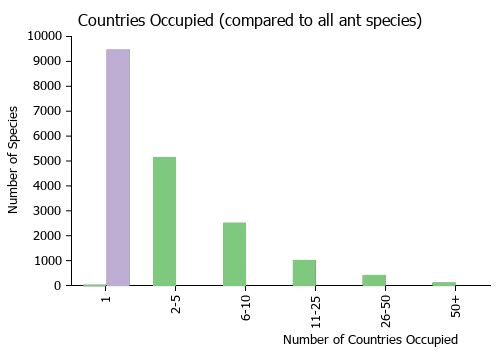Pheidole hedlundorum
| Pheidole hedlundorum | |
|---|---|
| Scientific classification | |
| Kingdom: | Animalia |
| Phylum: | Arthropoda |
| Class: | Insecta |
| Order: | Hymenoptera |
| Family: | Formicidae |
| Subfamily: | Myrmicinae |
| Tribe: | Attini |
| Genus: | Pheidole |
| Species: | P. hedlundorum |
| Binomial name | |
| Pheidole hedlundorum Wilson, 2003 | |
This species is only known from type specimens. The type series was collected from leaf litter in wet montane forest. (Wilson 2003)
Identification
See the description in the nomenclature section.
Keys including this Species
Distribution
Only known from the type locality.
Latitudinal Distribution Pattern
Latitudinal Range: 10.06687° to 10.06687°.
| North Temperate |
North Subtropical |
Tropical | South Subtropical |
South Temperate |
- Source: AntMaps
Distribution based on Regional Taxon Lists
Neotropical Region: Venezuela (type locality).
Distribution based on AntMaps
Distribution based on AntWeb specimens
Check data from AntWeb
Countries Occupied
| Number of countries occupied by this species based on AntWiki Regional Taxon Lists. In general, fewer countries occupied indicates a narrower range, while more countries indicates a more widespread species. |

|
Estimated Abundance
| Relative abundance based on number of AntMaps records per species (this species within the purple bar). Fewer records (to the left) indicates a less abundant/encountered species while more records (to the right) indicates more abundant/encountered species. |

|
Biology
Castes
Nomenclature
The following information is derived from Barry Bolton's Online Catalogue of the Ants of the World.
- hedlundorum. Pheidole hedlundorum Wilson, 2003: 435, figs. (s.w.) VENEZUELA.
Unless otherwise noted the text for the remainder of this section is reported from the publication that includes the original description.
Description
A large, medium reddish brown (major) or plain light brown (minor) member of the flavens group, with a mostly smooth, shiny body surface and dense, exceptionally long pilosity. Similar to lustrata, differing in the major in lighter body color, larger size, rounded humerus in dorsal-oblique view, presence of wavy hairs on the promesonotum; and less extensive foveolation on the mesopleuron and propodeum; and in the minor in the broader occiput in full-face view, more posterior position of the eye, round eye shape, and shorter scape length.
See also the less similar Pheidole browni, Pheidole chalca, Pheidole nitidicollis, Pheidole terresi, and species close to them listed in the diagnoses.
MEASUREMENTS (mm) Holotype major: HW 1.20, HL 1.20, SL 0.62, EL 0.14, PW 0.58. Paratype minor: HW 0.60, HL 0.62, SL 0.58, EL 0.10, PW 0.40.
COLOR Major: body rich medium reddish brown, appendages a lighter shade.
Minor: light brown, tarsi yellow.
Figure. Upper: holotype, major. Lower: paratype, minor. Scale bars = 1 mm.
Type Material
VENEZUELA: Estado Aragua, Rancho Grande, 1100 m, col. William L. and Doris E. Brown. Museum of Comparative Zoology
Etymology
Named in honor of Charles and Helen Marie Hedlund, in recognition of their outstanding contribution in service and support to tropical conservation, hence the habitats in which the Pheidole ants will continue to exist.
References
- Wilson, E. O. 2003. Pheidole in the New World: A dominant, hyperdiverse ant genus. Harvard University Press, Cambridge, MA. (page 435, fig. major, minor described)
References based on Global Ant Biodiversity Informatics
- Wilson E. O. 2003. Pheidole in the New World. A dominant, hyperdiverse ant genus. Cambridge, Mass.: Harvard University Press, [ix] + 794 pp.
